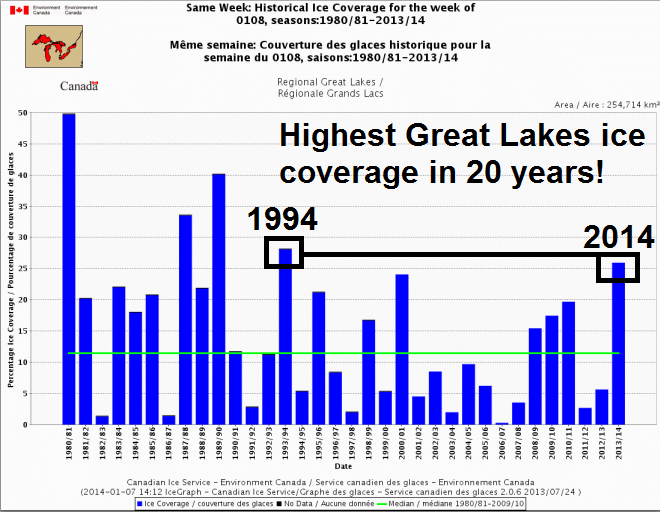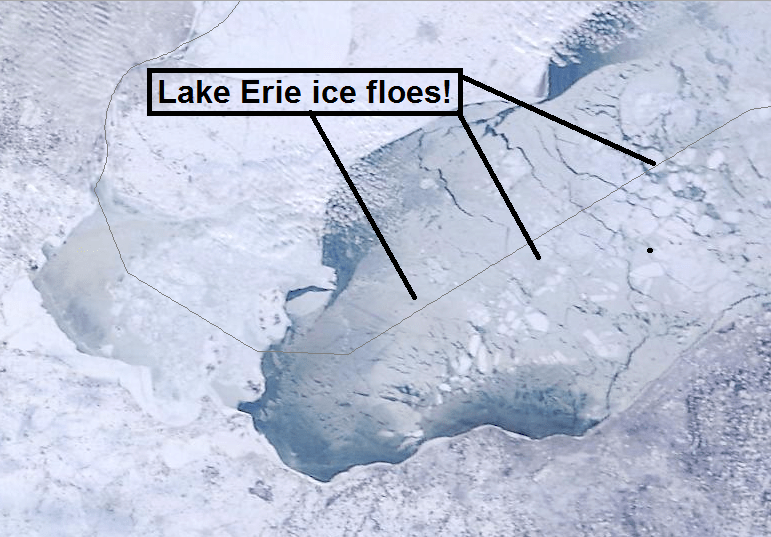Polar vortex drives Great Lakes to highest ice cover in 20 years

Go Deeper.
Create an account or log in to save stories.
Like this?
Thanks for liking this story! We have added it to a list of your favorite stories.
We're all feeling an early icy chill this winter. So are the Great Lakes.
A cold December and January's intense polar vortex driven arctic outbreak increased Great Lakes ice cover increased from 12 to 26 percent in the past week. That's the highest early January ice coverage on the Great Lakes in 20 years. Here's the historical data from the Canadian Ice Service.

Several bays on the Great Lakes are now notably choked with ice. Here's the latest coverage map from the National Oceanic and Atmospheric Administration's Great Lakes Environmental Research Laboratory.

Ice coverage on Lake Erie has reached 90 percent in recent days. Here's a closer look at the extensive ice cover on western Lake Erie from NASA's Moderate Resolution Imaging Spectroradiometer (MODIS) 250 meter resolution visible image of Jan. 9.
Turn Up Your Support
MPR News helps you turn down the noise and build shared understanding. Turn up your support for this public resource and keep trusted journalism accessible to all.

Here's a great shot from the Buffalo, N.Y., office of the National Weather Service that shows just how quickly the polar vortex ice over shallow Lake Erie.

Lake Superior: Highest ice cover in more than a decade
It's been a cold start to winter at the head of the Great Lakes in Duluth. December temperatures ran -10.2 degrees vs. average in Duluth. Last week's massive arctic blast drove ice levels higher on giant Lake Superior.
[image]
I asked Jay Austin, associate professor at the University of Minnesota-Duluth's Large Lakes Observatory, for some perspective on the ice levels on the big lake so far this winter.
Hi Paul-
I've attached a graphic that Dan Titze, one of my grad students, put together a few days ago, showing ice coverage ( >10%) on 9 January from the last 9 years. You can see that we are WAY ahead of where we've been at least in the last decade.
Here's the graph of Superior ice on Jan. 9 for the past decade.

Here's a closer look at the data, which shows a mean concentration of 23 percent on Lake Superior as of Jan. 13.

Good news for lake levels?
There are many benefits from increased ice cover on the Great Lakes. One benefit is that more ice cover means less evaporation. That can help sustain lake levels. Weather Underground's Jeff Masters has an interesting take on this.
The increased ice coverage on the Great Lakes this winter is good news for water levels on the lakes, which are still struggling to recover from some record lows recorded at this time last year.
During January 2013, water levels on Lake Michigan and Lake Huron fell to their all-time lowest values since record keeping began in 1918, 29 inches below the long-term average. While the water levels recovered substantially during 2013, which was one of the wettest years in Michigan's history, water levels were still a foot below average at the beginning of 2014.
The above average ice cover this winter will reduce evaporation from the Great Lakes, keeping water loss lower than in recent winters. Ice cover on the Great Lakes has declined 71% since 1973, according to a 2012 study published in the Journal of Climate by researchers at NOAA's Great Lakes Environmental Research Laboratory.
The loss of ice is due to warming of the lake waters, which could be due to a combination of global warming and natural cycles, the researchers said. Winter air temperatures over the lower Great Lakes increased by about 2.7°F (1.5°C) from 1973 - 2010, and by 4 - 5°F (2.3 - 2.7°C) over the northern Lakes, including Lake Superior.
Lake Superior's summer surface water temperature warmed 4.5°F (2.5°C) over the period 1979 - 2006 (Austin and Colman 2007). During the same period, Lake Michigan warmed by about 3.3°F (1.7°C), Lake Huron by 4.3°F (2.4°C), and Lake Erie (which is shallow and loses and gains heat relatively quickly) showed almost no warming.
Another benefit is that ice cover largely shuts down the prolific lake-effect snow squalls that dump snow by the foot downwind from the Great Lakes. That much snow can be difficult to dig out from!




